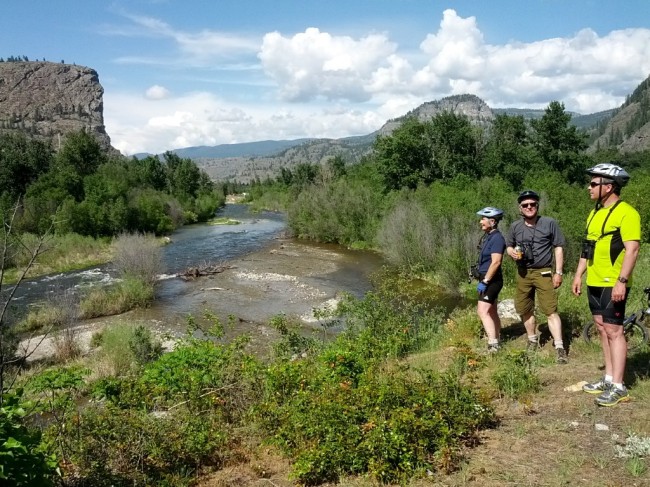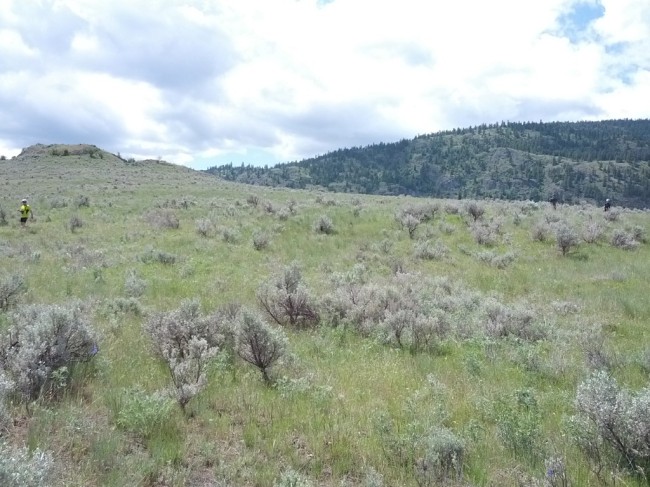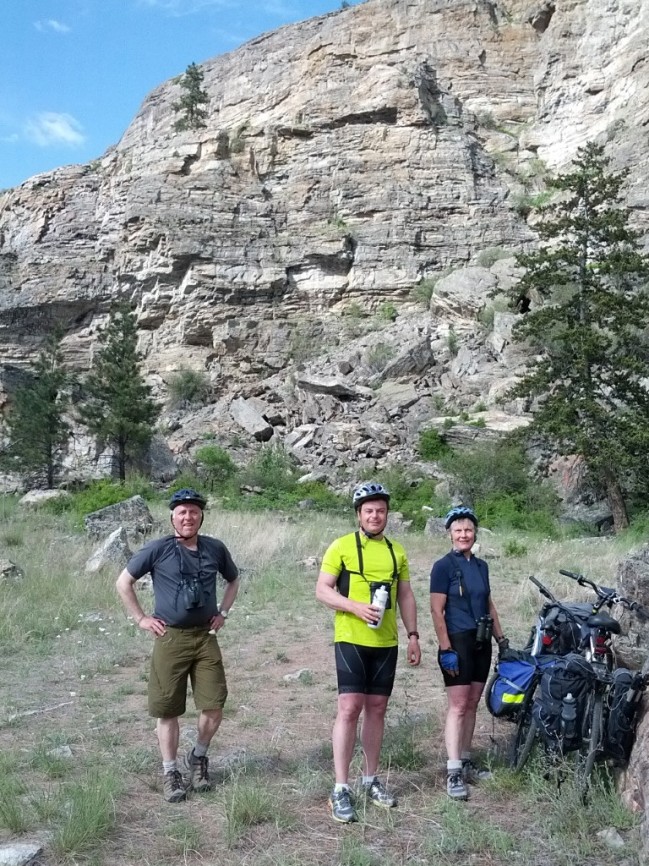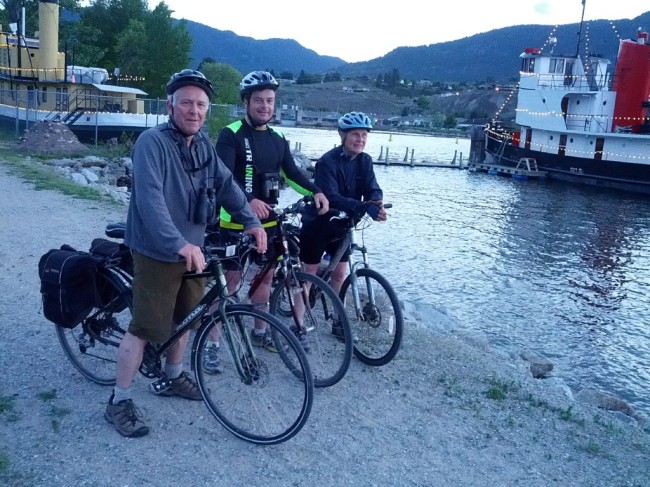Bicycle Birdathon 2014
The day began with a huge sigh of relief. The weather forecast for the past few days had shown a solid day of rain for Sunday—the Sunday of the Victoria Day weekend, the traditional day for the Okanagan Big Day Challenge. And it’s one thing to do a Birdathon in the rain, but to do a bicycle Birdathon in the rain all day is something I’d rather not contemplate. Hence the relief when I stepped outside at 2:15 a.m. and saw starry skies and felt not a breath of wind. John Reynolds and George Clulow arrived at about 2:45 and we were off on our bikes in the darkness. We met our fourth team member, Eva Durance, at the start of the Max Lake Road at 3:15, just as a Common Poorwill called from the ponderosa pines ahead of us. Species number one—we’d need a few more to reach our goal of 130! Eva said it was species number two for her—she’d heard a Great Horned Owl calling as she left her house.
We clattered through the potholes to Max Lake, where a Sora called, then a Virginia Rail—things were going as planned. A couple of kilometres later we passed a parked car and a couple of small tents right where we usually try for Flammulated Owls, so I quietly led the group a few hundred metres on so as not to disturb their sleep. After a few imitated hoots, a Flam called in the distance, then another. We climbed the steep hill to check the nest-boxes, but no owls looked out—too early in the season, I imagine. It was 4 a.m., still dark, so we had nothing to do but lie back in the pinegrass and wait for the dawn and its chorus of songbirds. A few seconds later a robin called and the frantic early morning listing began.
We slowly worked our way back down to Max Lake itself, the pines and firs ringing with Townsend’s Solitaire, Western Tanager and Black-headed Grosbeak song. The temperature had dropped a few degrees, and we kept adding layers and gloves but still got good and chilled. By 5:20 we had 30 species, enough to feel good heading down the big hill to my house. A Great Blue Heron flying high overhead was a surprise—and a relief, since their small colony in Penticton had shifted and was hard to see from our route. A Eurasian Collared-Dove flew up from the roadside—this species had finally colonized my neighbourhood after several years of taking over surrounding towns. At home we refuelled with hot coffee and repacked our bags for the long ride to the south. Eva spotted a Black-chinned Hummingbird at the feeder, but a Rufous chased it off before the rest of us could get a look. Hopefully we’d be able to make that one up along the way.

Looking a little brighter at 6:30 a.m.! Eva, myself, George and John set out from my home to continue the adventure.
At 6:30 we were off again, down the KVR trail to the Okanagan River. Several Lazuli Buntings sang from the bushes, and a single Yellow-breasted Chat—just arrived from Mexico last night—sang from the rose thickets below. Along the river we picked up most of the swallows, but the Bank Swallows weren’t at their usual bank—I only had a couple of sure spots for this species so hoped this wouldn’t be a bad miss. We looked out over Okanagan Lake, where a single Western Grebe and 3 Bufflehead were nice additions, as was a young Ring-billed Gull on the beach. Gulls are hard to find in May in these parts!
This was one of the earlier dates we can do a Birdathon, and several species hadn’t been reported yet as back from their wintering grounds. We listened hard for Willow Flycatchers, Gray Catbirds, Eastern Kingbirds and Veeries along the cottonwood groves by the river, but no luck. The muddy oxbow east of the Penticton airport had pairs of Northern Shovelers, Gadwalls and Yellow-headed Blackbirds, but most of the other ducks had flown north in the past week, and there were no interesting shorebirds at all. A quick stop at the Skaha Lake beach produced a single Common Loon and a dozen more Western Grebes.
It was time for the first big physical effort of the day—the 7-km climb along Hwy. 97 to Kaleden. In the past, we’ve gone down the east side of Skaha, which is less hilly, but for a change this year I decided to reverse the day—putting the big climb in the morning and leaving the level biking for the afternoon and evening. We’d also avoid the traffic congestion of the Peach City Half Marathon along that east side route. The others quickly pulled away on the big hill as my lack of conditioning became apparent. I listened for Lark Sparrows along the way, but the only new species I saw along that stretch was a raven. I caught up to the gang in Kaleden, where a Lewis’s Woodpecker soared out from a hilltop snag.
At 9:15 we turned off on the White Lake Road, quickly adding Western Wood-Pewee and Hammond’s Flycatcher before stopping in at Doreen Olson’s home at the top of the first big hill. Doreen was off leading a Meadowlark Festival field trip, but had kindly left a jug of cold water on her porch for us to refill our bottles. An adult Great Horned Owl looked down on us from the big fir where they’ve nested for over a decade, and a male Black-chinned Hummingbird came to the feeder, allowing the rest of us to catch up to Eva in one fell swoop. We hung around Doreen’s for 25 minutes or so, hoping to get the White-breasted Nuthatch that was there yesterday, but eventually gave up and tackled the next big hill on the route.
After adding American Kestrel and Say’s Phoebe in the first kilometre, a small black car pulled up—it was Catherine Jardine and friends, out doing some serious Okanagan target birding. Catherine pointed out that it was their camp along the Max Lake Road; had I known I wouldn’t have felt so bad about hooting for owls outside their tent! I gave them directions to a Black-throated Sparrow discovered the day before at Osoyoos, handed them the map and cycled off while they went back to Doreen’s for the Black-chinned Hummingbird. I caught up to the rest of the gang as they were pointing out a Pine Siskin at a feeder—this usually common species had been basically absent from southern BC for the past six months so we were relieved to get one. I reached for my notebook to write it down and discovered that I hadn’t just given Catherine the map to the sparrow, I’d handed over my notebook with the map in it. Arggh! Luckily, Eva had also been keeping a running tally of our birds.
A quick side trip to a small pond produced a family of Barrow’s Goldeneye ducklings and a Green-winged Teal, a Bald Eagle soared over the next lake and a Wilson’s Snipe called from the marsh. Then on to White Lake, where the grasslands held great promise for new species. A Western Bluebird at a nest box, Brewer’s Sparrows singing from the sagebrush, Savannah Sparrows still migrating through the basin. Catherine and gang drove by again and dutifully handed back my notebook. We stashed our bikes and hiked up the hills to the south of the lake in a traditional march to find Gray Partridge and Grasshopper Sparrow. These marches have usually been fruitless, but they provide some relief from the bicycle saddle and I simply love walking the grasslands in spring. It was hard to listen through the din of meadowlark and Vesper Sparrow song, but near the top of the rise I caught the insect-like trill of a Grasshopper Sparrow (species 100!), and soon we all had good looks as he sang from atop a sagebrush. No partridges, but we were happy with the results of the walk. After a long hard look we found four Wilson’s Phalaropes on the lakeshore as White-throated Swifts chattered overhead. It was noon.
We sailed down the big Park Rill hill south of White Lake, slamming on the brakes to see a lovely adult Golden Eagle over the cliffs to the west. We stopped at a nearby nest box that had had a Western Screech-Owl looking out of it yesterday—no sign of the owl, and a broken egg below the box didn’t bode well. I boosted Eva up on my shoulders to look into the box, but it was empty. I trilled my best screech-owl trill, but only managed to call up an astonishing variety of forest birds—no owl (and no White-breasted Nuthatch—yikes). We stopped at the Secrest Scout Camp to look for nuthatches, but by now it was 2 p.m., sunny, hot and windy. The forests were quiet as we checked a number of bluebird boxes, hoping to find one being used by the local White-breasted Nuthatches. We bumped into Michelle Hamilton and Grant Halm, members of our team in previous years, but they had no nuthatch information to pass on.
As we got to the big flats at Covert Farms, I saw Marianne Hutterli through the pines, planting in her vegetable garden. I mentioned to John that Marianne was a local birder, and he immediately said “We should ask her about White-breasted Nuthathes!” So we turned off the road, then up her driveway. To our surprise, she replied to our blurted question “Oh yes, we have a nuthatch nest in our house.” And there, under the eaves, was a little gap in the boards through which a pair of White-breasted Nuthatches were shuttling to feed their young. After some more water refills, we thanked the Hutterlis and were off to River Road, sailing down the extraordinary Secrest Hill, which I can attest is a big challenge to cycle up! At the bottom of the hill we ran into the convoy of the Western Teenagers, a group of young birders that were doing a car-powered Big Day in the area. We tore away from their excited stories to check off Bank Swallow around the next corner (phew!), and there unexpectedly met more birding friends, including Dan Kemble, the compiler of the Carcross, YT Christmas Bird Count, someone whom I’ve talked with many times on the phone but never met. Such is May birding in the Okanagan!

Looking for Vaux’s Swifts (or Hooded Mergansers, or Merlins, or anything new!) along the Okanagan River south of McIntyre Bluff
A male Cinnamon Teal was a bonus at Hack’s Pond, but we couldn’t find a Bewick’s Wren along River Road. A Vaux’s Swift twinkled overhead as we got back on the highway and headed north to Vaseux Lake. We were well down in our species total so were hoping Vaseux would come through in a big way to get us back into respectability. At the south end of the lake a few Redheads and a single Lesser Scaup were joined by a pair of Blue-winged Teal flying in. Then John spotted a pair of Red-necked Grebes dancing along the marshy shoreline. Things were looking up. At 4:00 pm we cycled up the McIntyre Creek road to the big cliffs—a kilometre of hill I wasn’t planning on—but were rewarded with Rock and Canyon Wrens singing. No Chukar cackled, though. A run out on the boardwalk produced Pied-billed Grebe, Cedar Waxwing, Marsh Wren and some distant Ring-necked Ducks. We stopped in at the Vaseux Lake Bird Observatory site and hiked over to the river channel, where we spotted a pair of Northern Harriers, but no kingfisher. It was 6 p.m. when we left, and our total was 118.
I really wanted to get to 120, but what could we add? A stop in Okanagan Falls failed to produce Merlin, and the dippers hadn’t been at the dam for a couple of years. We cycled along the west side of Skaha Lake along the old KVR trail, praising its condition on the southern end and cursing its deep sand, silt and gravel on the northern half. Finally, just as we reached the north end of the lake, a Belted Kingfisher called to us as it perched over the shore on a shrub. 119. No Lark Sparrow, though. We were hoping from some new shorebirds at the airport oxbow, but only saw the usual gang of ducks and killdeer. As we went by the cottonwoods farther north I slowed down, hoping to hear the nasal call of a Veery. Instead I heard a soft “whit!” that sounded a lot like a Willow Flycatcher. We stopped and spent a long time trying to get a good look at the bird, but it stayed frustratingly low in the shrubs. I finally got a short but good view of a brownish flycatcher, orange lower mandible, enough for me to call it a Willow. The 120th species. We finished the day at the south end of Okanagan Lake, 9 p.m. nothing new. One last hill up to home and we were done, in more ways than one. With 104 kilometres behind us, we had the pleasure of collapsing into bed and storing another year’s worth of memories in our Okanagan Big Day Challenge memory banks! Remember–this is all in aid of bird conservation and the Vaseux Lake Bird Observatory–if you’d like to make a Birdathon pledge to our team, click here. Thanks!




